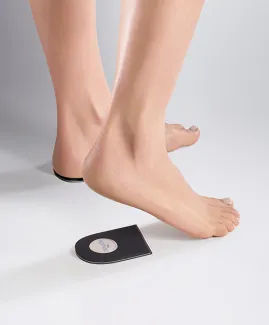
The causes of plantar fasciitis can be of anatomical, mechanical or physiological nature. In this article, find out about what causes plantar fasciitis or heel spurs thanks to a detailed description by EPITACT®.
Are the causes of plantar fasciitis the same as those of heel spurs?
The difference between plantar fasciitis and heel spurs is often confused. Indeed, both conditions have the same symptoms, the same causes and the same treatments. Even if heel spurs are thought to be the cause of pain due to their pointy shape, plantar fasciitis is the real culprit. Indeed, this inflammation of the plantar fascia progressively leads to a calcium deposit at the base of the heel: the heel spur.
Why do heel spurs and plantar fasciitis cause heel pain?
Plantar fasciitis is inflammation of the fibrous membrane on the bottom of the foot called the plantar fascia. This membrane goes from the heel to the toes.
This inflammation can be caused by excessive stress on the plantar fascia, either due to anatomical abnormalities or overuse (sport practice, inappropriate shoes, being overweight…). Indeed, the repetition of high stresses on this small area causes microtears on the plantar fascia and then inflammation. Pain appears under the heel but it can also spread to the arch of the foot(2).
NB: Many authors think that the cause of plantar fasciitis is degenerative rather than inflammatory(1).
Mechanical causes of heel spurs and plantar fasciitis
Intense activities
One of the most frequent causes of plantar fasciitis is foot overload and overuse. Some occupations, sports and hobbies involve intense and repetitive movements that cause excessive stress on the plantar fascia (jumping, running, standing for long periods…).
For example, runners, either amateur or professional, are the most affected sportspersons(1). During running, the fascia stretches continuously. This overuse triggers excessive tension at the insertion of the fascia on the heel bone, causing microtears and inflammation of the tissue. In the same way, standing for too long gives rise to foot overload and overuse.
If the activity that causes plantar fasciitis is not restrained, the inflammation leads to the plantar fascia thickening and loss of elasticity, as well as a bone spur(3)!
Inappropriate shoes
Shoes that do not absorb enough the impact of the foot with the ground also increase the risk of causing a heel spur. For example, avoid shoes with a too thin or flat sole and wear shoes with a cushioning sole which supports the arch of the foot, and preferably with a small heel (3 to 4 cm).
Being overweight
Excess weight is a major cause of plantar fasciitis(4). It presses the feet and their components, thereby increasing stresses at the insertion point of the fascia on the heel bone. Moreover, it accelerates plantar fat pad ageing (the thick fatty layer that covers the sole of the foot). As a result, the foot does not cushion the impact between the foot and ground sufficiently and pressure increases even more.
Plantar fasciitis: causes related to anatomy
According to some authors, there is a genetic predisposition to plantar fasciitis or heel spurs(2). Indeed, every person who is overweight or practices intense activities doesn’t necessarily have the condition.
Foot shape
Birth disorders like fallen or high arches (flat feet or hollow feet) can increase the stress on the plantar fascia. We can also distinguish postural factors like foot pronation and supination, when the foot tends to tilt inwards and downwards, respectively. These particular foot shapes increase our understanding of what causes plantar fasciitis.
Plantar fat pad atrophy
The plantar fat pad protects the deep structures of the foot and acts as a natural cushioning insole. If the plantar fat pad loses thickness or elasticity, no matter the reason (age, excess weight), stresses increase on the fascia.
This list of causes of plantar fasciitis is not exhaustive. Other factors like unequal leg length, tension in the posterior chain muscles (calf muscles and hamstrings) or limited ankle flexion upwards can also play a part(1).
Physiological causes of heel spurs and plantar fasciitis
Age
Plantar fasciitis seems to be more frequent among middle age or elderly people. The most affected age group is the 40-60(3), probably due to the change in gait over the years. The contact between the foot and the ground is longer and walking is slower. Age also involves degeneration of the plantar fat pad and natural ageing of tissues.
Gender
Women are more affected by heel spurs and plantar fasciitis than men(2), especially because wearing high heels causes plantar fasciitis (or increases the risk of having it). Indeed, this type of shoes tends to disrupt the functioning and shape of the foot.
To help you relieve pain and inflammation, EPITACT® has created the heel lifts*. By raising your heel of a few millimetres, they reduce the stress of the plantar fascia. They are made of PHYSIO’CHOC™, a that provide shock absorption while walking and a small pad of silicone gel under the heel limits pressure on the painful area.
Thin and adhesive, they fit any type of closed footwear and stay very well in place. Discover the other conservative treatments for plantar fasciitis and heel spurs HERE.
*This solution is a class I medical device that bears the CE marking under this regulation. Carefully read the instructions before use. Manufacturer: Millet Innovation. 10/2023
For more details about this general and simplified approach, here are further sources:
(1)Trojian T, Tucker AK. Plantar Fasciitis. AFP. 15 juin 2019;99(12):744‑50.
(2)Kirkpatrick J, Yassaie O, Mirjalili SA. The plantar calcaneal spur: a review of anatomy, histology, etiology and key associations. Journal of Anatomy. 2017; 230(6):743‑51.
(3)Hasegawa M, Urits I, Orhurhu V, Orhurhu MS, Brinkman J, Giacomazzi S, et al. Current Concepts of Minimally Invasive Treatment Options for Plantar Fasciitis: a Comprehensive Review. Curr Pain Headache Rep. sept 2020;24(9):55.
(4)Frey C, Zamora J. The Effects of Obesity on Orthopaedic Foot and Ankle Pathology. Foot Ankle Int. sept 2007;28(9):996‑9.
 Pharmacie
Pharmacie